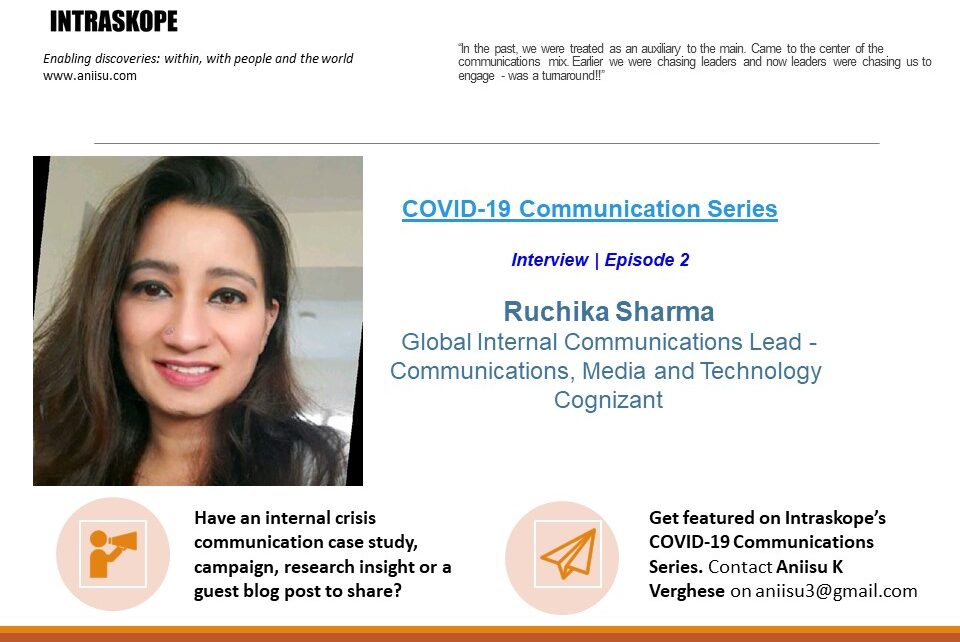How did internal communicators deal with the evolving crisis? What approaches were adopted and how did they communicate effectively? Read all this and more in this interview with Ruchika Sharma who is listed in India’s 50 Best Corporate Communications Leaders. Ruchika currently serves as the Global Internal Communications Lead- CMT (SDM) at Cognizant.
The COVID-19 Internal Communications Interview Series looks at ideas, campaigns and insights from practitioners who engaged hands-on as the crisis evolved.
- How did internal communications work during COVID-19?
A shared microsite was created. Focus was on how to go about business. Material was there to support from home. How to deal with these times. What kind of conversations were we supposed to have? My previous employer as a company created case studies during this time helping customers think of how they must be planning for the future. Communicating with employees invited them to take leave and manage stress. We also asked them to take the free mental health counselling offer and time off to spend with their family. We emphasized on how to engage clients.
2. When was the communications team involved? What was the approach taken to involve the team? Was it a formal invite, a call, email, Teams, or business as usual?
It wasn’t a matter of concern because we were assuming it was just in China. It started dawning upon us that this pandemic was spreading. We had a global call and got involved immediately.
3. What were the key channels used? Which were the most effective? Why?
We had a culture of using Sharepoint. Globally and with different practices, for regions. We used e-mails but not so much. 3-4 mails per week was a mandate we had globally because we shouldn’t be overcommunicating. We influenced people to pivot to other comms channels. MS Streams was more focus on videos. Fact that everyone was working from home meant that videos needn’t be professional shot and they could be recorded on handheld phones. It was a way to see into peoples’ lives.
4. How was communication created, reviewed and published? What kind of communications did employees receive during and after a crisis?
During Wave 1, most of the communications was about supporting the business and clients, maintain sanity at work and how to work from home.
For Wave 2, the focus was more on the crisis, how to support yourself during these times. What can you do to stay in shape and manage work. The transition happened seamless between the two, I believe communicators can sense when we need to pivot.
5. What were the biggest challenges and opportunities for communicators? Why?
The biggest challenges: as a communicator were to put internal communications in the spotlight. Despite all these years, when we have taken the business forward, we have not been given the importance we deserved. Internal communications became the one function that everyone wanted to talk to. We received the biggest volume of work between March and April 2021. We had to also keep business running as usual. So it was overwhelming. We weren’t really equipped with resources. Had to communicate a lot, also know, how to not overcommunicate.
In terms of opportunities, we were able to prove how important internal communications is to the overall business. In the past, we were treated as an auxiliary to the main. Came to the center of the communications mix. Earlier we were chasing leaders and now leaders were chasing us to engage – was a turnaround! Attrition was high and we became consultants in the truest sense. Doing virtual meets and round tables were part of the opportunities we tapped.
6. What specific lessons did they learn from the pandemic and the communications related to it?
When there is a crisis, you don’t look at the time. You need to get it done. The organizations and people need it We need to be sensitive about the messages. Do their best and keep their clients happy when they are struggling to breathe. The focus shifted – you can’t have the goals and objectives have to be the same. You can’t do fun stuff when there is a tragedy worldwide. Agility during a crisis is important. Adapting to the situation, fast things are changing. You won’t succeed. Sense the pulse and sentiments in the organization.
7. Which skills were the most valued during this time?
Agility and adaptability. Being sensitive. Know what people are going through. Change the tonality of messages.
8. What measures of success were used to gauge the effectiveness? How did you know if the communication was received well or not?
One of the biggest challenges we have always is measurement. We can measure the external measures. No number of surveys are enough due to lack of time. Metrics like intranet readership, e-mail open rates and time spent are crucial to analyze. Mindset and behavioral changes such as attitudes are important to measure the real impact of communications. If people read mails but don’t change behavior, it doesn’t matter.
Missed the first episode of the COVID-19 Internal Communications Interview Series? Read it – Nazia Nasim (Royal Enfield – India)
Have other insights to share? Join the COVID-19 Internal Communications Interview Series! Drop a mail to me at [email protected]
